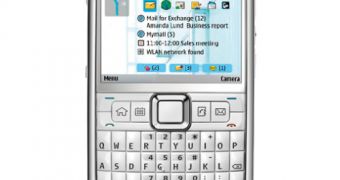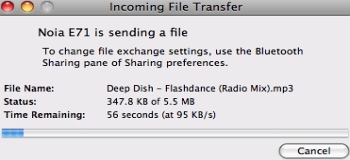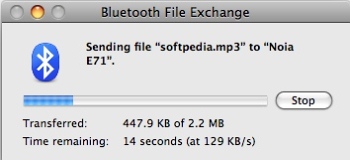The highly acclaimed Eseries developed by Nokia had its up and downs in the course of time. Starting with the controversial E61 model, that offered a QWERTY keyboard sacrificing the pocket-sized form, the Eseries had its fans, but also its enemies. I believe that the new E71 repairs some of the ill reputation of its E61 and E61i predecessors, coming with a fresh and appealing look. Nokia E71 seems to be the all-in-one messaging tool, especially designed to satisfy even the most exigent businessman. A little bit smaller and slimmer than E61, but also lighter, the E71 is the perfect update to the Eseries portfolio in terms of design and functionality.
Announced in June 2008, Nokia E71 was launched on the market one month later, in July. The business phone can be acquired for the nifty sum of USD 550$, but can easily go lower, depending on the location and plan. There are two colors available for buyers: White Steel and Grey Steel.
Design
The 'Pie' form of E61 and E61i has been reshaped and resized to smaller dimensions, which are more appropriate for an age of 'anorexic handsets'. There's a huge difference between the last Eseries handset (E61i) and the E71 in terms of size, but small in terms of layout. With only 10mm thickness, the E71 is surely one of the slimmest business mobile phones on the market. Also, its measures (114mm x 57mm) and weight (127 grams including battery) near the so much desired 'pocket-sized' form.
The QWERTY keyboard layout is pretty much the same as its E61 and E61i predecessors, with some exceptions on the last row of keys. The E61i features 39 keys, while the new E71 has only 37. The missing keys are 'Chr' and '( )', and the Space key has been enlarged a little bit. Even if E71 has two keys short compared with the E61i, the missing functions have been included on other keys, so everything is in place.
The space between the keys is much smaller, which means the keypad is more crowded, but at least they're protruding, so you're safe texting. The keys are extremely responsive, so I advise users to keep the keypad locked when they're not using it.
Above the 2.4'' TFT display, there's a secondary camera, which can be used for video-calls, but not for taking pictures, and also an ambient light sensor. The left side of the phone features an Infrared port, the microSD slot card and the microUSB port. The right side includes the two volume keys and the Voice recording key, as well as a small 2.5 jack port for headset. Unfortunately, there's no camera dedicated key, so you're limited to the use of the D-pad, which makes taking portrait mode snapshots a little awkward.Nokia has strangely placed the loudspeaker on top of the phone, as well as the usual power button. Unfortunately, the latter looks cheap and because it has a very different color (RED), it will unpleasantly stand out from the rest of the device. The small charger port has been obviously left for the bottom of the phone, where you can also find a small eyelet. On both sides of the handset, near the bottom, there are two slim keys. These open the metallic back cover when pushed simultaneously. The 3.2 Megapixel camera on the back features LED flash, auto-focus and self-portrait mirror, but lacks any protective cover. Almost the entire backside of the unit has been made from a metallic compound, which is scratch resistant, while the rest of the phone is made from very well polished plastic, which looks exquisite.
Overall, Nokia E71 looks compact and sturdy, keeping the same 'PIE' design line of its E61 and E61i predecessors. We already know that E71 targets businessmen, but it also has the potential of impressing even fashionistas.
Display and Camera
Both display and camera are a bit of let-downers in terms of functionality. The 2.4'' TFT display is way smaller than E61i's 2.8'' screen, but at least supports the same 16 Million colors and 320x240 pixels resolution. Fortunately, quality is the same, which means that E71 features a high standard display that performs very well under bright sunlight and is well protected against scratches. For performance, please check the benchmark results below:
The 3.2'' Megapixel camera is one of the main drawbacks of the phone. I suggest to those who intend to buy the device to forget about the camera and concentrate on the rest of the phone's features instead.
The 3.2'' Megapixel camera with LED flash and auto-focus capabilities is good, but the low quality of the pictures, as well as the fact that it lacks any protective cover, makes it less competitive. One thing that clearly suggests that the phone is not intended to perform very well in terms of picturing is the fact that it doesn't have a dedicated camera button. That makes the whole process of taking pictures in portrait mode rather annoying, as pictures can only be made by pressing the D-pad. Not to mention that you need to press two buttons if you want to use the auto-focus feature of the phone: pressing the 'T' key focuses the camera, while pressing the 'D-pad' actually takes the picture. The LED flash is useless in dark environments, so night pictures are out of the question. The camera interface is pretty straight forward with functions like: White balance, Color tones, Scene modes, Exposure compensation and Self timer. When taking pictures, the maximum resolution available for the camera is 2048x1536 pixels, while movies can be recorded in QVGA mode at 15fps (H.263, MPEG-4 formats). Not necessarily the main attraction of the handset, the 3.2 Megapixel camera performs just enough to satisfy a businessman.Menu and Software
Nokia E71 runs Symbian 9.2 operating system, with S60 3rd Edition and Feature Pack 1 interface. This Pack offers several improvements and adds some new features, like an alarm clock, vCalendar 2.0, support for 3D graphics and hardware acceleration, as well as screen turning. The repeated alarm clock provides users with the wake up call whenever they want, so they don't have to buy third party applications for that purpose.
The main menu can be accessed by pressing the second left key ('House' icon), next to the D-pad controller. In addition to the usual options and applications that we find in almost all Symbian-powered handsets, Nokia E71 features Search and Maps utilities. Maps is used together with the GPS receiver and enables owners to use Nokia maps, localization and directions when they're on the go. Lots of maps can be downloaded from Nokia's website and then used to pick the shortest route from one point to another. Under the Office category, we find QuickOffice applications, used for reading Word, Excel and PowerPoint files, but also for editing these files, so there's no need to upgrade the application.
There's also a complex calendar, a dictionary, a PDF reader, a Notepad, a Zip archivator, a calculator, a currency converter, a voice recorder (active notes), a file manager, printers and a support for wireless keyboard. All applications pre-installed or third party apps installed after buying the device are placed in the Installations sub-menu. It offers some interesting applications such as: Multiscanner (Card reader), Advance Call Manager, WiPresenter, WorldMate, Yahoo!Go. The phone includes everything a businessman may need on the road or at the office, pre-installed on the handset: email, web, calendar, organizer, IM, office tools, messaging, applications manager, connectivity wizard, synchronization tools, GPS navigator, themes, profiles, and even more. Media sub-menu comprises of utilities present in almost all Symbian-based devices: Recorder, Music player, Gallery, RealPlayer, Podcasting, Radio, Flash Player, 3-D tones, Music store. When accessing the Tools section of the menu, one can discover some goodies that weren't previously specific to Eseries devices: Switch (transfers content, such as contacts, from a compatible Nokia device to E71 handset using Bluetooth or Infrared), Encryption, Modes (changes one home screen to another customized screen), Voice aid, Barcode reader. Nokia E71 is definitely a huge step forward when it comes to business phones and not only a simple upgrade of the older E61 and E61i.Communications
Nokia E71 is a quad band GSM (850 / 900 / 1800 / 1900) handset, HSDPA (3.6 Mbps) compatible, which features GPRS class 32 (100 kbps), EDGE 32 class (296 kbps), High-Speed Circuit-Switched Data (57.6 kbps) and Wi-Fi 802.11 b/g. Tested on the EDGE and 3G networks, the phone performed a little bit above average, as you can also see in the screenshots.
We obtained the best results when testing the WLAN network speed: 769 Kbit/s download and 29 Kbit/s upload. This proves that the phone can actually reach higher numbers on both EDGE and 3G, but was limited by the operator's network (Orange). The WLAN wizard helps you search and define your WLAN network connection settings. If you want to connect to the Internet, you must first define an Access point (EDGE, WLAN or 3G). You can do that by going to Main menu - Tools - Settings - Connection - Access points, and define which access point to be used whenever a network connection is required (Main menu - Home network – Settings). Other connectivity tools include Bluetooth 2.0 with A2DP and EDR support, and microUSB for PC synchronization (no charging). The Bluetooth connection reached almost 95 KB/s with ease, so you'll be able to transfer data fast. When connecting the USB cable, you'll be able to choose among four modes: PC Suite, Mass storage, Media transfer, Connect PC to Web. All four modes are intuitive and easy to use, so there's nothing more to add here. Unlike E61i's Pop-port, Nokia E71 features a microUSB port, which makes the process of synching more 'pleasant', but I would have preferred the old miniUSB connectivity port. The built-in GPS receiver features the A-GPS function, which makes localization even faster. I tested the phone and I didn't have any trouble with satellite signal. The GPS located my position in about three minutes and the strength of the signal was above average. Rarely, when in traffic, I noticed some lags, but otherwise it worked flawlessly in conjunction with the Nokia Maps. In terms of messaging, the phone offers a complete messaging solution accepting all available message types. Further, given the full QWERTY keypad, it's a real pleasure to text or edit documents. The phone includes no less than four message editors, one for each type: SMS, MMS, audio message and e-mail. The message client works with POP3, SMTP, and IMAP4 protocols, and supports more than one email account. Also, it can download headers and supports attachments. The quad-band (GSM 850 / GSM 900 / GSM 1800 / GSM 1900) network compatible handset has a very good GSM signal reception, but I have noticed some serious drops in various indoor locations. Moreover, the UMTS signal reception is only at half strength, so I don't recommend accessing it unless you intend to use the phone to browse the Internet or to make data transfers. The sound is above average in quality at both ends, and pretty loud. The vibration alert is also above average in intensity, so you don't really need to set it to higher levels.Processor and Memory
Nokia E71 is powered by a single ARM11 family processor running at speeds of up to 369 Mhz.
It's a better choice for E71 compared with the other Eseries devices. Nokia E71 worked fine even when accessing more than one application, and no freezes were noticed. The handset embeds 100 MB user free internal storage memory, 128 MB SDRAM and 256 MB NAND memory. Bear in mind that just 71 MB is free executable RAM memory. Anyway, storage space can be expanded up to 8GB through the hot-swappable microSD slot card. The sales package includes a 2GB microSD card (just like N82), but that might depend on the location.Multimedia
There's not much to tell in terms of multimedia features, except that E71 includes all the specific functions, but to a mediocre level. The music player included looks very nice and supports AAC, AAC+, eAAC+, MP3 and WAV music file formats. It features Equalizer (Bass booster, Classical, Jazz, Pop, Rock and Default), Balance, Loudness and Stereo widening. Files can be automatically sorted by artist, genre, and album.
The integrated FM Radio can record up to 50 base stations and features the Visual Radio functions. Reception is very good, but sound is a little bit of a let-down if you don't change the HS-47 stereo headset that comes with the phone. The same goes for the music player sound, but don't expect too much quality even with good headphones. The Bluetooth 2.0 with A2DP support enables users to listen to music wirelessly. Videos can be played with the help of the integrated Real Player application, which can run clips in full screen mode.Battery
The 1500 mAh Li-Polymer (BP-4L) battery has an officially stated life expectancy of 410 hours in standby and of about ten hours and 30 minutes in talk time mode. Basically, it's the same battery that powered the older E61i, but it seems that E71 eats 50% less energy. We only needed one charge per week and that is a unique case. The phone has been heavily used for calls, Internet surfing, data transfer, taking pictures. Nokia E71 is definitely the least energy consuming handset made by Nokia at the moment.
Impressions
Nokia E71 is the perfect business phone for the features it includes, but also for the cool design. One of the few business phones that will stand out from the crowd, Nokia E71 is definitely high value for low price. If you wanted to buy the E61 or E61i, but were stopped by their big size or heavy weight, then E71 will certainly please you.
The Good
The Bad
Sales package
Nokia E71 handset
Nokia Battery (BP-4L)
Nokia Charger (AC-5)
Nokia Connectivity Cable (CA-101)
Nokia Headset (HS-47)
Nokia Eseries Lanyard
Nokia Eseries Pouch
User Guide, Quick Start Guide and other documentation
2GB microSD depending on market/channel.

 14 DAY TRIAL //
14 DAY TRIAL // 



































































































